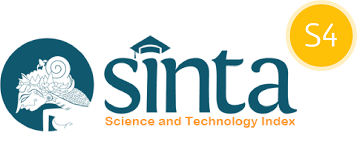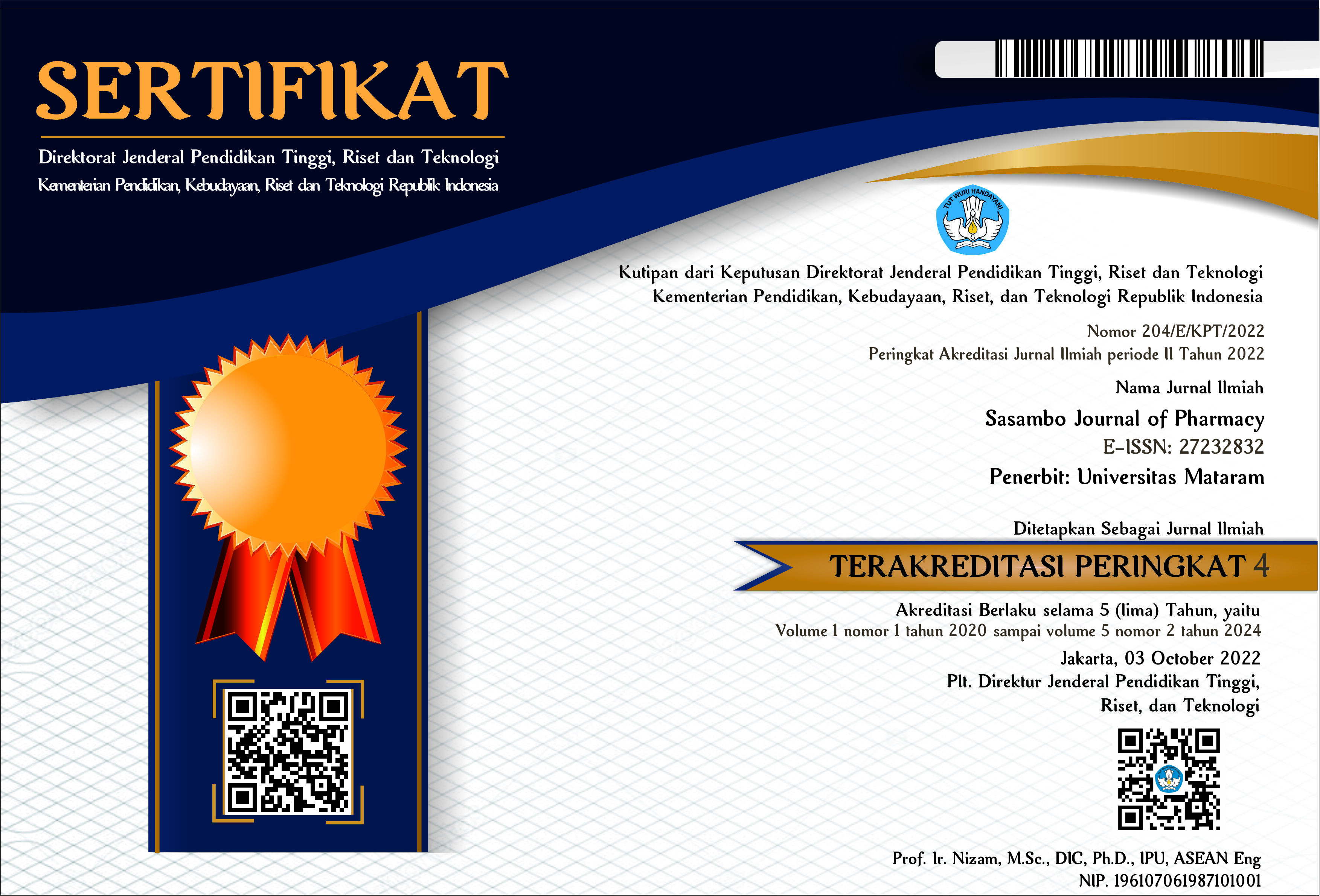Potensi interaksi obat pada pasien skizofrenia di Rumah Sakit Jiwa Mutiara Sukma tahun 2020
DOI:
10.29303/sjp.v3i1.151Downloads
Abstract
Schizophrenia is a chronic mental disorder characterized by distortions in thinking and behavior. Schizophrenic patients receive antipsychotic therapy (main) and non-antipsychotic (supportive) for a long time. Prescription drugs are given either single or in combination, that can possible for drug interactions. This study objective to determine the potential drug-drug interactions in schizophrenic patients. The design of this study was cross-sectional with purposive sampling technique. The data used is secondary data from the medical records of inpatient schizophrenia patients at the Mutiara Sukma Mental Hospital NTB in 2020 with a retrospective method. The sample data obtained were 109 medical records. The results showed that there were 82,2% of drug interaction cases, namely the combination of risperodone and lorazepam. The number of major interaction cases is 24,2%, moderate is 72,1% and minor is 3,6%. The high incidence of drug interactions in schizophrenic patients requires closely monitored.
Keywords:
Schizophrenia, Drug Interactions, AntipsychoticsReferences
American Psychiatric Association. (2015). Choosing Wisely ?: Five Things Physicians and Patients Should Questions. American Psychiatric Publishing.
American Psychiatric Association. (2020). Practice Guideline for the Treatment of Patients With Schizophrenia. American Psychiatric Publishing.
Baxter, K. (2010). Stockley's Drug Interactions. Pharmaceutical Press.
Bruijnzeel, D., Suryadevara, U., & Tandon, R. (2018). Antipsychotic treatment of schizophrenia: An update. Asian Journal of Psychiatry, 1–5. https://doi.org/10.1016/j.ajp.2014.08.002.
Depkes RI. (2015). Keputusan Menteri Kesehatan Republik Indonesia Nomor HK.02.02/MENKES/73/2015 tentang Pedoman Nasional Pelayanan Kedokteran Jiwa. Jakarta: Departemen Kesehatan RI.
Faizah, A. K., & Nurrahman, N. W. D. (2021). Evaluation of potential drug-drug interactions in hypercholesterolemia patients at teaching hospital Surabaya. Age, 67, 33.
Gründer, G., Heinze, M., Cordes, J., Mühlbauer, B., Juckel, G., Schulz, C., Rüther, E., & Timm, J. (2016). Effects of first generation antipsychotics versus second generation antipsychotics on quality of life in schizophrenia: A double-blind, randomised study. Lancet Psyhiatry. (16), 1–13. https://doi.org/10.1016/S2215-0366(16)00085-7
Hommers, L., Scharl, M., Hefner, G., Hohner, M., Fischer, M., Pfuhlmann, B., Deckert, J., & Unterecker, S. (2018). Comedication of valproic acid is associated with increased metabolism of clozapine. Journal of Clinical Psychopharmacology, 38(3), 188–192. https://doi.org/10.1097/JCP.0000000000000877
Konsensus Penatalaksanaan Gangguan Skizofrenia. (2011). Konsensus penatalaksanaan gangguan skizofrenia. Perhimpunan Dokter Spesialis Kedokteran Jiwa Indonesia, 94. https://www.drugs.com/ Diakses pada tanggal 10 Januari 2022, 09.00 WITA.
Krause, M., Huhn, M., Schneider-thoma, J., Rothe, P., Smith, R. C., & Leucht, S. (2018). Antipsychotic drugs for elderly patients with schizophrenia: A systematic review and meta-analysis. European Neuropsychopharmacology, 1–11. https://doi.org/10.1016/j.euroneuro.2018.09.007
Maylani, R. Y., Fadraersada, J., & Ramadhan, A. M. (2018). Studi pemberian antipsikotik terhadap beberapa jenis skizofrenia di RSJD Atma Husada Mahakam Samarinda. Proceeding of Mulawarman Pharmaceuticals Conferences, 267–275. https://doi.org/10.25026/mpc.v8i1.333
Odhejo, Y. I., Jafri, A., Mekala, H. M., Hassan, M., Khan, A. M., Dar, S. K., & Ahmed, R. (2017). Safety and Efficacy of antipsychotics in pregnancy and lactation alcoholism & drug dependence, Journal Alcohol Drug Depand. https://doi.org/10.4172/2329-6488.1000267
Puspitasari, A. W., & Angeline, L. (2019). Analisis Potensi interaksi obat golongan antidepresan pada pasien skizofrenia di Rumah Sakit Jiwa Dr. Soeharto Heerdjan Tahun 2016. Pharmaceutical Sciences and Research (PSR), 6(1), 13–20.
Sadock, B.J., & Sadock, V. A. (2013). Kaplan and Sadock's Synopsis of Psychiatry: Ninth Edition. Pippincot Williams and Wilikins.
Salwan, J., Woldu, H., Rosen, A., & Katz, C. L. (2013). Application for Inclusion to The 19th Expert Committee on The Selection and Use of Essential Medicines: Risperidone. World Health Organization.
Yulyanti, R., & A. Y. R. (2021). Analisis Potensi Interaksi Obat Antidepresan pada Pasien Skizofrenia di Rumah Sakit Swasta Bandung Januari-Juni 2021. Jurnal Sosial dan Sains. 1 (10), 170–1180.
Yuspita, E., Hasina, R., & Puspitasari, C. E. (2021). Profil Drug Related Problems (DRPs) Penggunaan Antibiotik pada Pasien Anak dengan Diare Infeksi di RSUD Provinsi NTB Tahun 2018. Jurnal Sains Dan Kesehatan, 3(4), 424–428. https://doi.org/10.25026/jsk.v3i4.436
License
Copyright (c) 2022 The Author(s)

This work is licensed under a Creative Commons Attribution 4.0 International License.
Authors who publish with Sasambo Journal of Pharmacy (SJP), agree to the following terms:
- Authors retain copyright and grant the journal right of first publication with the work simultaneously licensed under a Lisensi Creative Commons Atribusi 4.0 Internasional. This license allows authors to use all articles, data sets, graphics and appendices in data mining applications, search engines, web sites, blogs, and other platforms by providing an appropriate reference. The journal allows the author(s) to hold the copyright without restrictions and will retain publishing rights without restrictions.
- Authors are able to enter into separate, additional contractual arrangements for the non-exclusive distribution of the journal's published version of the work (e.g., post it to an institutional repository or publish it in a book), with an acknowledgment of its initial publication in Sasambo Journal of Pharmacy
- Authors are permitted and encouraged to post their work online (e.g., in institutional repositories or on their website) prior to and during the submission process, as it can lead to productive exchanges, as well as earlier and greater citation of published work (See The Effect of Open Access).







